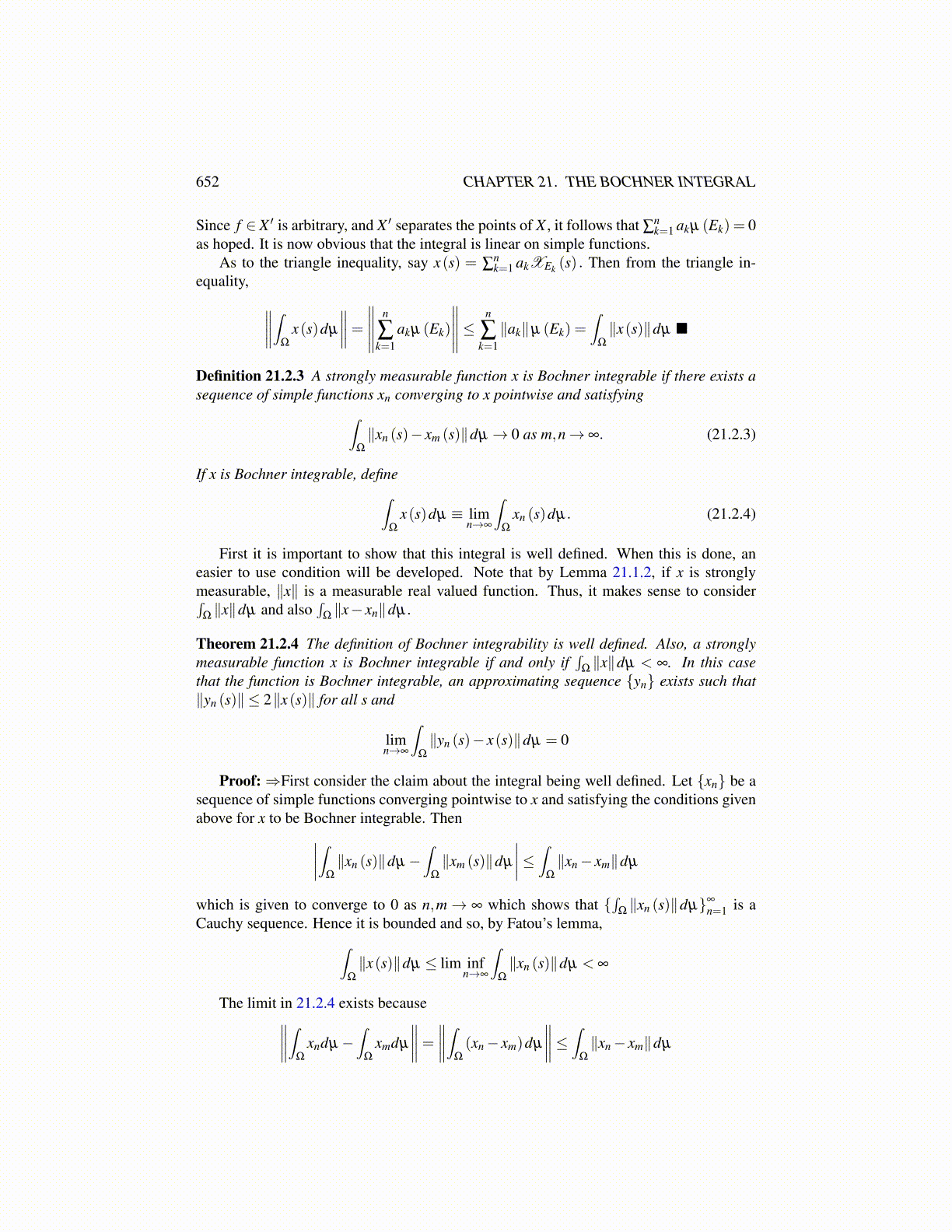
652 CHAPTER 21. THE BOCHNER INTEGRAL
Since f ∈ X ′ is arbitrary, and X ′ separates the points of X , it follows that ∑nk=1 akµ (Ek) = 0
as hoped. It is now obvious that the integral is linear on simple functions.As to the triangle inequality, say x(s) = ∑
nk=1 akXEk (s) . Then from the triangle in-
equality, ∥∥∥∥∫Ω
x(s)dµ
∥∥∥∥=∥∥∥∥∥ n
∑k=1
akµ (Ek)
∥∥∥∥∥≤ n
∑k=1∥ak∥µ (Ek) =
∫Ω
∥x(s)∥dµ
Definition 21.2.3 A strongly measurable function x is Bochner integrable if there exists asequence of simple functions xn converging to x pointwise and satisfying∫
Ω
∥xn (s)− xm (s)∥dµ → 0 as m,n→ ∞. (21.2.3)
If x is Bochner integrable, define∫Ω
x(s)dµ ≡ limn→∞
∫Ω
xn (s)dµ. (21.2.4)
First it is important to show that this integral is well defined. When this is done, aneasier to use condition will be developed. Note that by Lemma 21.1.2, if x is stronglymeasurable, ∥x∥ is a measurable real valued function. Thus, it makes sense to consider∫
Ω∥x∥dµ and also
∫Ω∥x− xn∥dµ .
Theorem 21.2.4 The definition of Bochner integrability is well defined. Also, a stronglymeasurable function x is Bochner integrable if and only if
∫Ω∥x∥dµ < ∞. In this case
that the function is Bochner integrable, an approximating sequence {yn} exists such that∥yn (s)∥ ≤ 2∥x(s)∥ for all s and
limn→∞
∫Ω
∥yn (s)− x(s)∥dµ = 0
Proof:⇒First consider the claim about the integral being well defined. Let {xn} be asequence of simple functions converging pointwise to x and satisfying the conditions givenabove for x to be Bochner integrable. Then∣∣∣∣∫
Ω
∥xn (s)∥dµ−∫
Ω
∥xm (s)∥dµ
∣∣∣∣≤ ∫Ω
∥xn− xm∥dµ
which is given to converge to 0 as n,m→ ∞ which shows that {∫
Ω∥xn (s)∥dµ}∞
n=1 is aCauchy sequence. Hence it is bounded and so, by Fatou’s lemma,∫
Ω
∥x(s)∥dµ ≤ lim infn→∞
∫Ω
∥xn (s)∥dµ < ∞
The limit in 21.2.4 exists because∥∥∥∥∫Ω
xndµ−∫
Ω
xmdµ
∥∥∥∥= ∥∥∥∥∫Ω
(xn− xm)dµ
∥∥∥∥≤ ∫Ω
∥xn− xm∥dµ